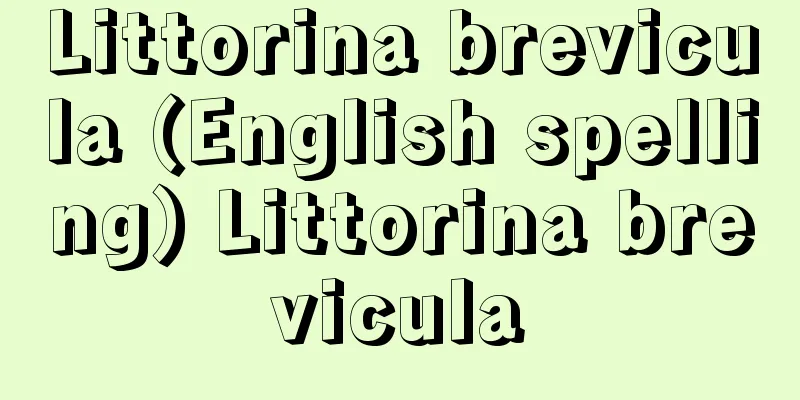Eirin - Eirin

|
An abbreviation for the "Film Ethics Code" or "Eirin Management Committee," which is used to enforce self-regulation over films in Japan. In Japan, film censorship was initially carried out by the police in each local cinema. In 1925 (Taisho 14), the Film Censorship Section was established in the Police Bureau of the Ministry of Home Affairs, and film censorship was centralized. In 1939 (Showa 14), the year after the National Mobilization Law came into force, the Film Law was enacted, and censorship was carried out from the script stage onwards. After World War II, state censorship was abolished, but film censorship was continued by the Supreme Commander for the Allied Powers (GHQ) during the occupation. In 1949, under the guidance of GHQ, the Motion Picture Association of Japan established the "Film Ethics Code" based on the American film censorship organization and regulations, and established the "Film Ethics Code Management Committee", which began voluntary regulation by pre-screening scripts and other elements. After 1950, the following subjects were added to the scope of review: advertisements, short films, etc. In the beginning, in line with the Occupation policy, the important issue was the compatibility of period films with democracy, but later the negative influence on young people became a social issue. Triggered by controversy over the American film "Violence Classroom" (1955) and Nikkatsu film "Season of the Sun" (1956), the government urged the film industry to strengthen regulations, and in January 1957, with the cooperation and request of the "Eirin Maintenance Committee" made up of filmmakers, a new organization was born, the "Eirin Management Committee", made up of private citizens, to regulate censorship. At the same time, foreign films were added to the scope of review, and in 1959 the Film Ethics Code was revised. In the 1960s, there was a rapid increase in films with themes of sex and violence. Director Takechi Tetsuji's Black Snow (indicted in 1965, acquitted in 1969), which had passed the Eirin screening, and Nikkatsu Roman Porno films (indicted in 1972, acquitted in 1981) were subject to criminal trial over obscenity. Genitalia and pubic hair, which had been a problem even after the 1980s, were not depicted in films, but in 1992, the Eirin regulations were revised to allow exceptions, although in principle they were not to be depicted. Eirin regulations also apply to films that have passed through customs. In the case of Love Affair (1995), co-directed by M. Antonioni and W. Wenders, the Eirin asked the distributor to modify the depiction of pubic hair after the customs office had allowed the film to be imported in its original form. However, the distributor requested a re-examination by the Eirin, and the re-examination committee eventually withdrew the request for modification, making this an exceptional case. Although restrictions usually occur during periods of social change, they have become less of a social problem due to the decline in the importance of films and the maturity of audiences, as seen in the 2000 film Battle Royale by Kinji Fukasaku (which was given an R15 rating by the Eirin, prohibiting viewing by those under 15, due to its violent content). Regarding video regulations, which had been an issue, the Video Ethics Council, consisting of the Japan Video Association, the Japan Film Association, and the Japan Video Software Association, has been in charge of reviewing video since 1995. However, there is still a lot of software that does not require approval, which has become a new issue. The Eirin Board of Directors is made up of five members including the chairman, eight or so expert judges (in charge of the Japanese film section, foreign film section, and advertising section), and one secretary-general, and covers its expenses through the collection of screening fees. It designates films as "adult films," which are prohibited for viewing by anyone under the age of 18, "restricted films (R)," which are prohibited for viewing by junior high school students and younger (R rating, since 1976), and "PG12," which indicates that parents or guardians are recommended for those under the age of 12 (since 1998). It has also set up an advisory body, the "Youth Film Council," which recommends good films and gives advice on problems. [Nobuo Chiba] "Eirin - History and Incidents," by Endo Tatsuo (1973, Pelican Publishing)" ▽ "In the Realm of the Senses Trial: Complete Record," volumes 1 and 2, edited by Uchida Takehiro (1980-1981, Shakai Hyoron Publishing)" ▽ "Film Censorship Report, July 1925 to February 1944, edited by the Ministry of Home Affairs, facsimile edition (1985-1986, Fuji Publishing)" ▽ "Cut-out Obscenity - A History of Eirin Cuts," by Kuwabara Inatoshi (1993, Yomiuri Shimbun)" ▽ "Film Yearbook, various years' editions (Jiji Film News Agency)" ▽ "Film Management Committee, edited and published, Film Management Committee Report, various years' editions" [References] | |Source: Shogakukan Encyclopedia Nipponica About Encyclopedia Nipponica Information | Legend |
|
日本における映画の自主規制を行うための「映画倫理規程」あるいは「映倫管理委員会」の略称。 日本の映画の検閲は、初めは映画館所在地の警察が個々に取り締まっていた。1925年(大正14)に内務省警保局にフィルム検閲課が設けられ、映画検閲が一元化された。国家総動員法が施行された翌年の1939年(昭和14)には映画法が制定され、脚本段階からの検閲が行われた。第二次世界大戦後、国家検閲は廃止されたが、連合国最高司令部(GHQ)による占領下の映画検閲が行われた。 1949年(昭和24)、GHQの指導によって、日本映画連合会は、アメリカの映画検閲組織と規程を範として「映画倫理規程」を制定、「映画倫理規程管理委員会」を発足させ、脚本等の事前審査形式による自主的な規制を始めた。翌1950年以後、宣伝、広告および短編映画を審査対象に加える。当初は占領政策に沿って、時代劇映画と民主主義との適応が重要な問題であったが、のちには青少年への悪影響が社会問題となった。アメリカ映画『暴力教室』(1955)や日活映画『太陽の季節』(1956)などの論議を契機に、政府は映画界に規制強化を促し、1957年1月、映画人による「映倫維持委員会」の協力、要請によって、民間人による「映倫管理委員会」が検閲規制する新組織の誕生をみる。同時に外国映画も審査対象に加え、1959年には映画倫理規程を改定した。1960年代に入ると、性と暴力を主題とする作品が急増した。映倫の審査をパスした武智(たけち)鉄二監督の『黒い雪』(1965年起訴、1969年無罪)や、日活ロマンポルノ映画(1972年起訴、1981年無罪)において、猥褻(わいせつ)性をめぐっての刑事責任が裁判で争われた。 1980年代以降も問題となりがちだった性器と陰毛(ヘア)表現は、1992年(平成4)の規定改定によって、原則としてその描写はしないとしながらも例外が認められるようになった。映倫規定は税関通関後の作品にも適用される。M・アントニオーニとW・ベンダース共同監督の『愛のめぐりあい』(1995)は、税関が原形のまま輸入許可をしたあと、映倫が配給者にヘア描写の修正を要求、しかし配給者は映倫に再審査を要請、結局再審査委員会が修正要求を撤回した例外のケースとなった。規制問題は社会の変動期に大きく起こることが通例だが、映画のウェイトの低下や、2000年の深作欣二監督の『バトル・ロワイアル』(暴力表現があるため映倫が15歳未満の閲覧を禁止する「R15」に指定)にみられた観客の成熟によって、社会問題化することは少なくなった。 また課題とされていたビデオ規制については、1995年(平成7)から日本ビデオ協議会、映団連、日本映像ソフト協会による映像倫理協議会が審査にあたることになったが、申請を求めないソフトが多く、新たな課題になっている。 映倫管理委員会の構成は、管理委員長以下管理委員5名、専門審査委員(日本映画部門、外国映画部門、宣伝広告担当)8名内外、事務局長1名よりなり、審査料の徴収によって経費をまかなっている。18歳未満の観覧を禁止する「成人映画」の指定と、中学生以下の観覧を禁止する「一般映画制限付(R)」の指定(R指定、1976年~)、12歳未満の場合は親または保護者の指導が望ましいとする「PG12」の指定(1998年~)などを行っており、また、諮問機関に「青少年映画審議会」を設け、優良映画の推薦や、問題についての助言をしている。 [千葉伸夫] 『遠藤龍雄著『映倫――歴史と事件』(1973・ぺりかん社)』▽『内田剛弘編『愛のコリーダ裁判・全記録』上下巻(1980~1981・社会評論社)』▽『内務省警保局編『映画検閲時報 大正14年7月~昭和19年2月』全40冊・複製版(1985~1986・不二出版)』▽『桑原稲敏著『切られた猥褻――映倫カット史』(1993・読売新聞社)』▽『『映画年鑑』各年版(時事映画通信社)』▽『映倫管理委員会編・刊『映画管理委員会報告』各年版』 [参照項目] | |出典 小学館 日本大百科全書(ニッポニカ)日本大百科全書(ニッポニカ)について 情報 | 凡例 |
<<: Forestry supervision system
Recommend
Halfbeak - Halfbeak
A fish of the family Halfbeakidae in the order Gar...
Two-star theory - Niseiryu-setsu
The theory that the velocity distribution of stars...
Australian giant crab (English name: Pseudocarcinus gigas; Australian giant crab; Tasmanian giant crab)
It is a member of the order Decapoda and family Po...
Enshu Dainembutsu - Enshu Dainembutsu
...The dancing nembutsu of the requiem dance also...
Kosay, HZ (English spelling) KosayHZ
...The Sphinx Gate was discovered in 1835, and as...
Pet Clinic
A veterinary hospital that primarily treats animal...
Céline - Louis-Ferdinand Céline
French novelist. At the age of 18, he volunteered...
Affiliated institutions - affiliated institutions
An institution attached to an administrative organ...
Sao people - Sao (English spelling)
A tribe that lived from the 10th century to the 16...
Toyotomi clan
This is a modern surname that began with Toyotomi...
Sekiyama Pass
A pass on the border between Sendai City, Miyagi ...
The Chinese Repository
…Born in Massachusetts, he came to Guangzhou in 1...
Brezovački, T.
...However, it was not until the 19th century tha...
Kouzuki [town] - Kouzuki
A former town in Sayo District, western Hyogo Pref...
Bella, JL (English spelling) BellaJL
…A Central European republic that existed from 19...









